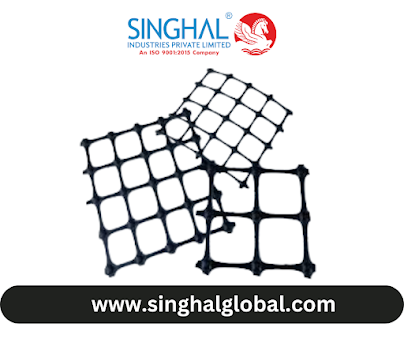Geomembrane Overview: Types, Applications, and Uses
A synthetic liner with extremely low permeability is referred to as a "geomembrane."
Hazardous liquids that, if not properly confined, could contaminate the earth or nearby structures are frequently contained using a geomembrane.
When using a geomembrane, the liner's chemical resistance is frequently given top priority.
For bigger-size liners where a specific type of liner is specified, the term "geomembrane liner" is used in engineering.
Different Forms of Geomemory
There are many kinds of geomembranes depending on the parent resin that is being used. Below is a list of the geomembranes that are most frequently utilized.
1. PVC Geomembrane
Vinyl, plasticizers, and stabilizers are the main components of PVC (polyvinyl chloride) geomembranes, which are thermoplastic waterproofing materials.
The polyvinyl chloride resin used in PVC geomembranes is created by polymerizing ethylene dichloride after it has been broken down into a dichloride.
Because PVC geomembrane is tear, abrasion, and puncture-resistant, it can be used to line tanks, landfills, sewage lagoons, and canals, and for soil remediation.
The substance is ideal for keeping clean water sources and preventing contaminants from getting in.
2. TRP Geomembrane
Polyethylene fabric is used for long-term water containment and industrial waste applications in TRP (Reinforced Polyethylene) geomembranes.
Due to their low-temperature range, chemical resistance, and ultraviolet stability, TRP geomembranes are a great choice for soil remediation, landfills, canals, lining temporary retaining ponds, agricultural, and municipal applications.
3. HDPE Geomembrane
Strong UV/temperature resistance, low material cost, durability, and good chemical resistance are all qualities of high-density polyethylene (HDPE).
Due to its larger thickness, which other geomembranes lack, it is the most widely utilized geomembrane. For projects including pond and canal lining, landfill covers, and reservoir covers, HDPE is the material of choice.
The chemical resilience of HDPE allows it to be used to store potable water.
4. LLDPE Geomembrane
The virgin polyethylene resins used to create LLDPE (Linear Low-Density Polyethylene) geomembrane give it strength, durability, and resistance against UV rays and low temperatures.
Engineers and installers who need an impermeable geomembrane typically choose LLDPE over HDPE because of its greater flexibility.
They are utilized in industrial settings for things like liquid storage tanks and containments for animal and environmental waste.
5. RPP Geomembrane
In order to give the material stability, chemical resistance, and flexibility, UV-stabilized polypropylene copolymer is used to create RPP (Reinforced Polypropylene) geomembranes, which are polyester-reinforced liners.
Its resilience and toughness can be attributed to the nylon scrim that supports it. For applications involving long-term water containment and industrial waste, RPP geomembranes are perfect.
RPP is ideal for evaporation pond liners, aquaculture, horticulture, and mine tailings.
6. EPDM Geomembrane
The rubber-like texture of the EPDM (Ethylene Propylene Diene Monomer) geomembrane contributes to its strength, flexibility, UV stability, and durability.
Extreme weather situations and resistance to punctures make them perfect. Typically utilized as surface barriers for dams, liners, covers, backyard landscaping, and other irrigation locations, EPDM geomembranes are simple to install.
Applications of Geomemory
If not properly managed, frozen, pooling, flowing, effluent, and standing liquids can be dangerous. Thus, geomembranes are employed to stop material loss.
Geomembranes are used for the following things:
- It is used in different trash conveyance canals as liners
- As liners for tunnels and pipelines that are watertight
- Serving as liners for the agricultural sector
- As the reservoir or potable water liners (for example, safe shutdown of nuclear facilities)
- To store and move liquids in the ocean, such as drinkable water
- As liners for the agriculture sector as liners for fish ponds
- To reduce deicing salt pollution, beneath roadways
- As liners for solid waste landfills and primary, secondary, or tertiary garbage piles
- Roads beside and below to catch spillage of potentially dangerous liquids
- As liners for radioactive, toxic, or sewage sludge liquid
- In emergency spillways as linings
- Storing and moving liquids in trucks
Geomembrane Application
Due to the product's adaptability, geotextile has gained popularity quickly across a variety of industries. There are several uses for geomembranes, some of which include:
- Farming and nurseries
- Marine (Pontoon building)
- Water Industry
- Manufacturing
- Mining industry
Benefits of geomembrane
- Positivity in water containment
- aid in maintaining water quality
- Install erosion control measures
- lower the cost of maintenance
- lower chance of disease
- Control trash disposal
- Prevent dissolved oxygen loss
- Increase the interval between corps' turnaround times
- Enhance the working atmosphere
Overall
Placing geotextiles is done to safeguard the environment and confine gases and liquids.
Because this liner system is more permeable, it is essential for both civil engineering and building.
Please feel free to contact our consultants for additional details.
.jpeg)

.png)
Comments
Post a Comment